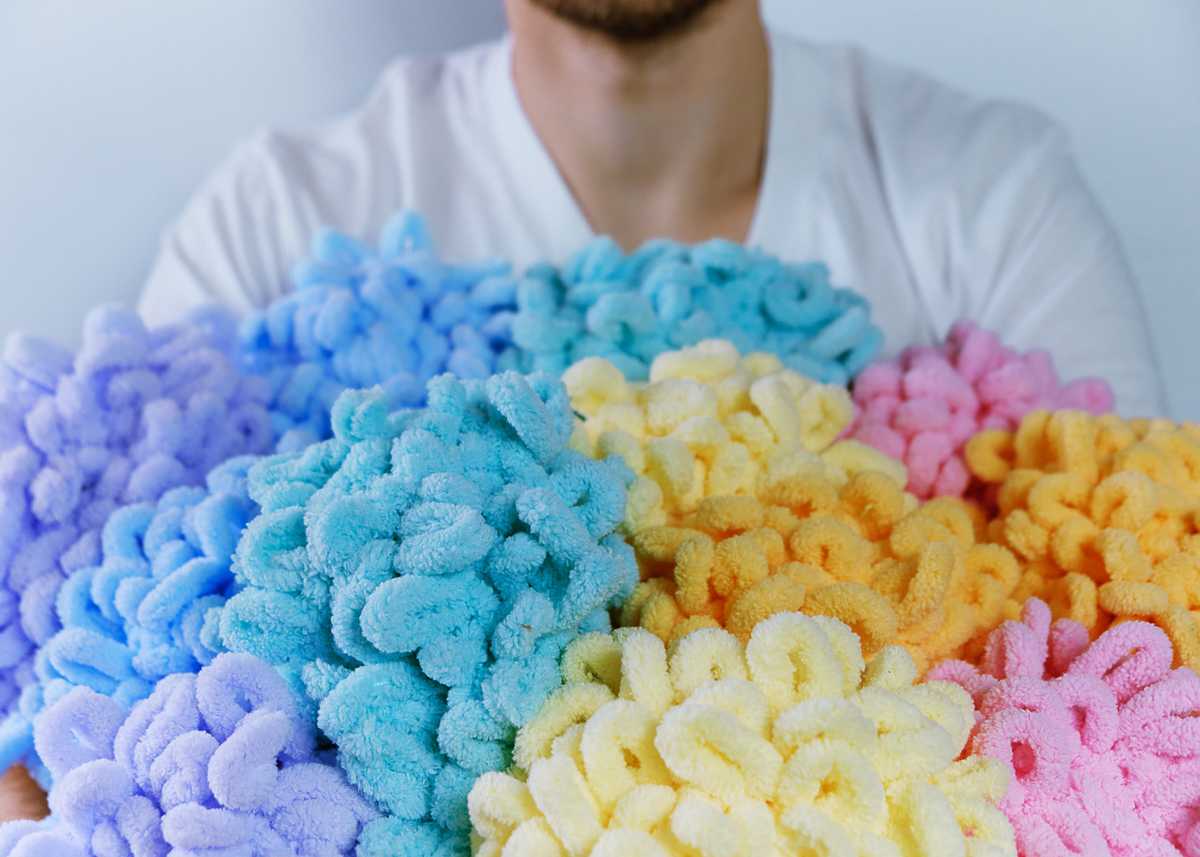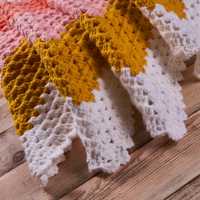How to Choose Yarn for Your Next Project
how to choose yarn for your next project
How to Choose Yarn for Your Next Project
By Linda K Murdock
How to Choose Yarn for Your Next Project
By Linda K Murdock
How to choose yarn for your next project, whether for knitting or crocheting, can be an overwhelming task. Your local yarn shop has a vast array of colors and textures. There must be a logical way to narrow down the choices. Focus on your particular yarn project or pattern and its function. Yarn shop staff should be able to direct you to the best yarn for what you are trying to do. But you might want to figure out for yourself how to choose yarn for your next project and here are some ideas that may help.
Is safety an issue? If you're going to do a hot pad as a beginning fiber artist, then you want to avoid acrylics, which will catch fire. If you are making a baby blanket, the roughness of hemp and itchiness of some wools is not such a great idea for either your hands or the baby. And if you are making stuffed animals or using a knobby or beaded yarn, make sure there are no choking hazards that may come off with vigorous use.
Is your item going to be used seasonally? That is, is this a summer frock or a heavy-duty winter item like a scarf, blanket or mittens? This will tell you whether or not you need a light weight or heavy weight yarn. Another factor to consider is whether the yarn wicks away moisture like wool or absorbs it like silk. Although acrylic is warm enough for winter wear, it's not very warm when it gets wet, and it doesn't breath or wick away moisture.
Clothes require other considerations, like those time consuming laundry concerns. Even though wool and cotton hold their shape well, they both shrink and wool can felt into a solid piece of fabric. Over time cotton has a tendency to stretch out. Acrylic is perhaps your best bet for washing and drying. Most of the other yarns will take a little more work, especially in the drying department.
Even what you would think is an easy decision - that of color - seems overwhelming with all the choices. Remember that a multi-colored variegated yarn will not show your difficult or dimensional stitches at all. If you want to do cables, then a solid, lighter color is best. Fancy yarns with lots of texture are also difficult for showing off your fancy stitches, not to mention they are challenging to work into a piece. Yarn that is not consistent in its thickness will cause fancy stitches to disappear and will be difficult to pull out if you make an error.
Many of us are impatient and want to see the end results of a project. If you are making a blanket or rug, then consider using a bulky or chunky yarn. Yes, it goes fast, but it adds the inches quite quickly and you can use more open stitches and a larger needle or hook compared to a simple stockinette or single crochet. The thickness of the yarn and the openness of your stitches help you see your amazing progress.
Don't be surprised if your yarn shop recommends a blend of synthetic, durable, easy-care yarns like nylon or acrylic, with the breathability of natural yarns like wool or cotton. This is especially true for socks, which need nylon (20-25%) to add strength in an area of constant abrasion. Socks must also breath and wick the perspiration from your feet, so a wool and nylon combination makes for a good fit.
It is very likely that you will come up with the same yarn that was first recommended by the yarn store expert. That tells you they not only know what they are doing, but that you are now knowledgeable enough to know how they came to the same conclusion as you have. That's a win-win situation. Next time you will know how to choose yarn for your next project, and you can shop with a lot less anxiety.
One final decision in how to choose yarn comes if you are making items to sell at craft shows. Do you ever wonder why there is such a large variance in prices? Perhaps the crafter wants to keep his or her item inexpensive and so uses the 100% acrylic or polyester yarns sold in discount stores. On the more expensive side, maybe the crafter believes in using only natural fibers and they cost more and so the crafter passes that expense on to you. Either way the crafter is often trying to please both the cost conscious, bargain hunting shopper and the handmade quality conscious buyer. It is not always an easy compromise. The good news is that either way, you'll end up with a uniquely handmade item that was made just for you.
Copyright 2015 by Linda K Murdock. Linda Murdock owns her own business, has written 4 books and blogs about Colorado and its crafty people. To find more tips on how to choose yarn for a project, read her full article at http://lindakmurdock.com/
Article Source: http://EzineArticles.com/expert/Linda_K_Murdock/1032615
How to choose yarn for your next project, whether for knitting or crocheting, can be an overwhelming task. Your local yarn shop has a vast array of colors and textures. There must be a logical way to narrow down the choices. Focus on your particular yarn project or pattern and its function. Yarn shop staff should be able to direct you to the best yarn for what you are trying to do. But you might want to figure out for yourself how to choose yarn for your next project and here are some ideas that may help.
Is safety an issue? If you're going to do a hot pad as a beginning fiber artist, then you want to avoid acrylics, which will catch fire. If you are making a baby blanket, the roughness of hemp and itchiness of some wools is not such a great idea for either your hands or the baby. And if you are making stuffed animals or using a knobby or beaded yarn, make sure there are no choking hazards that may come off with vigorous use.
Is your item going to be used seasonally? That is, is this a summer frock or a heavy-duty winter item like a scarf, blanket or mittens? This will tell you whether or not you need a light weight or heavy weight yarn. Another factor to consider is whether the yarn wicks away moisture like wool or absorbs it like silk. Although acrylic is warm enough for winter wear, it's not very warm when it gets wet, and it doesn't breath or wick away moisture.
Clothes require other considerations, like those time consuming laundry concerns. Even though wool and cotton hold their shape well, they both shrink and wool can felt into a solid piece of fabric. Over time cotton has a tendency to stretch out. Acrylic is perhaps your best bet for washing and drying. Most of the other yarns will take a little more work, especially in the drying department.
Even what you would think is an easy decision - that of color - seems overwhelming with all the choices. Remember that a multi-colored variegated yarn will not show your difficult or dimensional stitches at all. If you want to do cables, then a solid, lighter color is best. Fancy yarns with lots of texture are also difficult for showing off your fancy stitches, not to mention they are challenging to work into a piece. Yarn that is not consistent in its thickness will cause fancy stitches to disappear and will be difficult to pull out if you make an error.
Many of us are impatient and want to see the end results of a project. If you are making a blanket or rug, then consider using a bulky or chunky yarn. Yes, it goes fast, but it adds the inches quite quickly and you can use more open stitches and a larger needle or hook compared to a simple stockinette or single crochet. The thickness of the yarn and the openness of your stitches help you see your amazing progress.
Don't be surprised if your yarn shop recommends a blend of synthetic, durable, easy-care yarns like nylon or acrylic, with the breathability of natural yarns like wool or cotton. This is especially true for socks, which need nylon (20-25%) to add strength in an area of constant abrasion. Socks must also breath and wick the perspiration from your feet, so a wool and nylon combination makes for a good fit.
It is very likely that you will come up with the same yarn that was first recommended by the yarn store expert. That tells you they not only know what they are doing, but that you are now knowledgeable enough to know how they came to the same conclusion as you have. That's a win-win situation. Next time you will know how to choose yarn for your next project, and you can shop with a lot less anxiety.
One final decision in how to choose yarn comes if you are making items to sell at craft shows. Do you ever wonder why there is such a large variance in prices? Perhaps the crafter wants to keep his or her item inexpensive and so uses the 100% acrylic or polyester yarns sold in discount stores. On the more expensive side, maybe the crafter believes in using only natural fibers and they cost more and so the crafter passes that expense on to you. Either way the crafter is often trying to please both the cost conscious, bargain hunting shopper and the handmade quality conscious buyer. It is not always an easy compromise. The good news is that either way, you'll end up with a uniquely handmade item that was made just for you.
Copyright 2015 by Linda K Murdock. Linda Murdock owns her own business, has written 4 books and blogs about Colorado and its crafty people. To find more tips on how to choose yarn for a project, read her full article at http://lindakmurdock.com/
Article Source: http://EzineArticles.com/expert/Linda_K_Murdock/1032615




